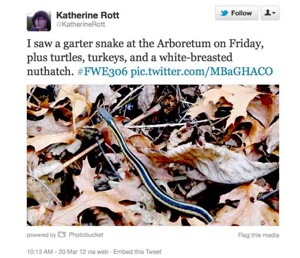UW wildlife students tweet from the field to let classmates know what they’ve seen
Now that migratory birds are back in Wisconsin and twittering in the treetops, a group of UW–Madison wildlife ecology students are paying close attention and doing some tweeting of their own.
Students in Anna Pidgeon’s Terrestrial Vertebrate Ecology class are looking for wildlife, in the woods, fields, parking lots and alleys, and they’re sharing their observations with their fellow classmates via Twitter.

Here is one of the tweets from Anna Pidgeon’s Terrestrial Vertebrate Ecology class.
“It’s pretty simple. The students must get a Twitter account, and then tweet a minimum number of wildlife sightings or behaviors over the course of the semester,” explains Pidgeon, an assistant professor of forest and wildlife ecology. “This exercise encourages them to look around, to notice things, like when cardinals first started singing this spring. It just makes them focus a lot more.”
Pidgeon requires her students to send 10 tweets over the course of the semester, but some send many more than that. To make it easy to find and read all of the class’ tweets, everybody adds the course number as a hashtag-a searchable Twitter keyword.
A lot of the tweets come from the woods and fields, but there are plenty of sightings of urban wildlife, along with the occasional road kill. Here are some of them:
“Tried to take out the garbage… Overly territorial raccoon in my apartments dumpster.”
“Heard a bat(s) chirping up a storm at a bonfire on the isthmus tonight. Lots of bugs have hatched recently, eat up little buddy.”
“Saw a house sparrow and house finch fighting on crabapple branch possibly competing for late-season food. Where was the house wren?”
“I saw a solitary Sandhill crane flying overhead. It was calling the whole time and that always gives me a good feeling.”
Sharing wildlife observations is only a small part of the course. The bulk of the work focuses on the defining characteristics, natural history traits and distribution of Wisconsin’s terrestrial vertebrates. Students have to learn these details for all 70 of the state’s mammals and all 56 reptiles and amphibians, as well as about one-quarter of Wisconsin’s 200-plus birds. That’s a lot of material to cover, and saving precious classroom time for that is what originally spurred Pidgeon to embrace Twitter.
“We used to take five minutes at the beginning of class to talk about people’s observations, but with about 50 students enrolled in the course each spring semester, that wasn’t very efficient,” she says. “Now I can monitor the sightings on Twitter, and comment during class on those that are especially notable.”
Interested community members can follow the class’ wildlife sightings by going to www.twitter.com and typing #FWE306 into the search bar. But please don’t add the hashtag to your own tweets, she requests.

